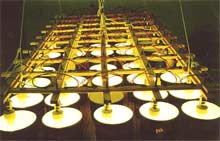Scientists of the University of Almeria, led by Gabriel Acién, are carrying out a research project on the development of new systems to eliminate carbon dioxide emissions through the use of microalgae photosynthetic activity.
’The mechanism developed is simple on paper. By the gas emission points a water tank would be installed in order to retain the pollutant gases resulting from a specific industrial process. This polluted water would go through a system of bioreactors with a microalgae culture system, which would then transform the CO2 emissions into vegetal matter and oxygen through the photosynthesis process’, researchers say.
This system also offers the added value of the resulting materials, as in addition to purified air, the organic matter obtained could be reused as fuel for biomass plants, transforming it into biofuel through fermentation or using it in agriculture.
This project, called CENIT CO2, is being developed by Spanish electricity company Endesa on the initiative of the Spanish Ministry of Industry. On the pilot plant developed at the experimental station of Las Palmerillas, which depends on Spanish bank Cajamar, Almeria-based researchers try to prove the validity of this new method for eliminating CO2 emissions. They expect that within one year, the system will be fully operative and therefore tests can be started at an industrial level. Researchers say that ENDESA, which is promoting this research line, may test its application in some of the facilities which, a priori, could show better results- the small gas plants.
Today, the single technology available with similar applications is based on the use of etanolamines, which do not have the added value microalgae have and also their applicability and profitability in industrial processes shows is not very satisfactory, the resulting gases being used for geological storage.
Greenhouses, another option to transform C02
In parallel to the above, and in collaboration with Madrid-based company Besel, researchers are trying to use CO2 directly in greenhouses. This way, if a small combined-cycle plant was installed in a greenhouse area, the gas would be insufflated to the greenhouses and the actual plants would then contribute to its depuration before being emitted into the atmosphere.
Today, they are experimenting how much CO2 is beneficial for tomatoes, peppers and cucumbers, and in what distribution rate. It is already known that this gas can even double the production of vegetables (in fact, its use in agriculture is rather expensive) but the appropriate amount for its whole life cycle and the tolerable proportion of other substances have not been determined yet.
Both the State and companies hope to find a way to reduce the CO2 emissions by carrying out different research lines. Some research groups focus on optimising the existing technology, whereas others try to improve the gas storage techniques (for example, using tanks similarly to the way radioactive waste is stored). Other alternatives are the search for better solutions in the combustion process (the used matter burns more and emits less gases), gas capture (not only etanolamines) and the valuation of the emitted CO2, which is the field in which researchers of the University of Almeria are working on. All these ways are within the CENIT project framework, designed by the Spanish Ministry of Industry..

